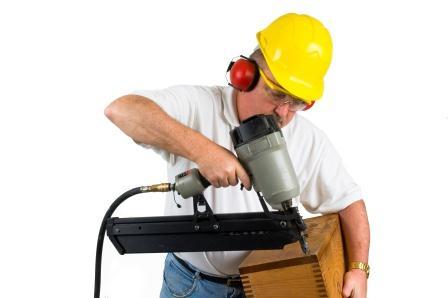The stats on nail gun use among carpenters aren’t exactly encouraging. Up to 40% are injured within their first 4 years of training. Twenty percent are injured twice within that period, and even 10% get hurt 3 times or more.
Here are some tips that can help nail gun users from becoming part of these unfortunate stats:
Make Sure You Wear Proper Protective Gear
These include the following:
- Hard hats
- Safety goggles (marked ANSI Z81.1)
- Earmuffs or earplugs
- Safety shoes to protect your toes
Available Information
Ignorance is no excuse for accidents, so the information that workers need should be readily available. This means that everyone should know where the manuals for the nail guns are, and it’s a good idea for workers to read them. The labels and instructions must be understood.
Proper Preparation
Everything should be set up right before you even use the nail gun. First of all, you should inspect your nailer to see that everything’s in place.
All malfunctioning nail guns must be taken out of service right away. Power sources should be checked out as well.
The surface of the slumber should also be looked over before you start nailing.
Look for potential issues such as other nails, knots, hangers, and straps that can cause a nail to ricochet or recoil. Set up the workplace so that people aren’t in the line of fire of your nail guns.
Avoid Nailing at Height
You may also want to set things up to minimize nailing at height (when you’re using a ladder). In fact, you may want to go with a scaffold instead of a ladder. If you do need to use a ladder, position it so that everything is within easy reach. As a guide, your belt buckle shouldn’t go past the side rails of the ladder when you’re reaching to the side.
It’s also a good idea to use full sequential trigger nail guns when you’re on a ladder. Other types of triggers can cause accidents when you climb up or down and bump your leg.
The key rule to using a nail gun while on a ladder is that you have to keep three (3) points of contact with the ladder constantly.
That means you’re breaking this rule when you hold the work piece with your hand while the other hand has the nailer.
Your feet then give you only 2 points of contact. So for placement work, you should use a clamp when you’re on a ladder.
Placement Work
If possible, just use a clamp to brace when you’re doing placement work even when you’re not on a ladder. If you do have to use your hands, don’t let them get within a foot from the nailing point at any time.
Using a Hammer
There are times when using a hammer just makes more sense. Use it when you can’t reach the work while you have your nailer in your dominant hand.
A hammer also makes sense for jobs at head or face height. The chances of recoil can have a rather horrific result during these situations. Finally, if you can’t use a full sequential trigger nailer, use a hammer instead when you’re working in a tight space.
Toe Nailing
You should always be careful with toe-nailing. Keep in mind that you can’t hold the nail gun flush against your work piece, and there’s always a chance that your nail gun can slip when you fire.
What you need is a nail gun with teeth on the safety contact. This will bite into the work piece so the gun won’t slip when you fire. Make sure you’ve properly positioned the safety contact piece before you fire the nail gun.
Disconnecting the Compressed Air
You have to disconnect the compressed air for the following circumstances:
- You’re doing some maintenance on the nail gun.
- You’re clearing jammed nails.
- You’re passing on the nailer to someone else.
- You’re climbing up or down a ladder.
- You’re leaving the nail gun unattended.
Never Ever Rules
Here’s a list of DON’Ts that everyone should be familiar with:
- DON’T fire the nail gun towards your body.
- DON’T fire the nail gun when someone is in the line of fire.
- DON’T use your non-dominant hand for the nail gun.
- DON’T pull on the hose to drag or lower the nail gun. If the hose gets caught on anything, just look for the problem and disconnect the hose.
- DON’T keep your finger on the trigger when you’re carrying or holding the nail gun. If you simply are unable to do this because you have fallen into a bad habit of having a finger on the trigger, you should go with a full sequential trigger. Or perhaps you should just lay the tool down until you need to fire it.
- DON’T disable or modify a nail gun safety device. This is just plain wrong, as there’s never a good reason to do this. This means you must never tape the trigger down so you don’t have to press it. You also can’t remove the spring from the safety-contact tip.
Conclusion
It does help a lot if you use nailers with a full sequential trigger, since this type of nailer is the safest among your trigger-type options. At the very least, have this for your least experienced workers. Even your veterans will prefer this as well when the work requires them to hold the lumber with the other hand.
Training (especially with a focus on safety) is also crucial, and establish your nail gun SOPs. Encourage the reporting of nail gun injuries, and make sure you always have first aid and medical treatment available.
Establish the rules, and train everyone to follow the rules.
Obey the rules yourself—it’s for your own good!

 October 10, 2019
October 10, 2019  5 Min
5 Min  No Comment
No Comment 




















